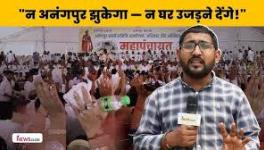How ‘Public Demolition’ Emerged as a Model of ‘Justice’ in Uttar Pradesh

Public demolition in Uttar Pradesh marks a lethal convergence of retributive governance, its support by a majority, articulated through popular culture and lionised by news media, and judicial insouciance.
———–
Few images have dominated the political discourse in recent times as much as the ‘bulldozer.’ For the Bharatiya Janta Party (‘BJP’), it stands for its ruthless but popular mode of performing ‘justice’ on those it sees as criminals or enemies. For critics, the image of a bulldozer relentlessly demolishing structures is an accurate depiction of the ruling party’s approach toward the rule of law, the autonomy of key public institutions, civil society, and policy-making. The literal bulldozers sprung to action in Uttar Pradesh, to begin with.
When a house is demolished, it is seldom a straightforward transaction involving the State, the accused, and the law. A demolition is witnessed, recorded, circulated, ‘liked’, commented upon, poeticized, memorialised, and perhaps, in Uttar Pradesh today produces more pleasure than pain. Demolition belongs to the genus of punitive measures which take place in the open, amidst, and for the viewers: a public demolition.
How did the public demolition, carried out through bulldozers, emerge as a means to deliver ‘justice’ in Uttar Pradesh?
Kanpur massacre and night of the bulldozer
The beginnings of ‘bulldozer justice’ lie in the sensational events which took place in Kanpur on the intervening night of July 2 and 3 in 2020. The police team which had been sent to nab gangster Vikas Dubey was ambushed by blocking its path using a bulldozer. Eight police persons were ruthlessly killed and seven were grievously injured by Dubey and his associates.
A demolition is witnessed, recorded, circulated, ‘liked’, commented upon, poeticised, memorialised and perhaps, in UP today, produces more pleasure than pain. Demolition belongs to the genus of punitive measures which take place in the open, amidst and for the viewers: a public demolition.
The incident sent shockwaves through the country and severely dented Adityanath’s image as a ‘strong’ Chief Minister. In retaliation, the next day the Kanpur district administration used the same bulldozer, which had blocked the police’s path on that fateful night, and razed the house and SUVs which belonged to Dubey. The demolition was live telecast and was hailed by mainstream media, providing the public with a sense of retributive justice. The UP government was quick to perceive the positive reception of the demolition. Right after the demolition of Dubey’s house, the Chief Minister ordered the demolition of all ‘mafia’ property. During the time of the pandemic and lockdowns, demolitions began all over the state as bulldozers roared through alleys and streets.
Interestingly, in the absence of any law which legitimised such swift extra-judicial demolitions, in court, the government took the preposterous position that in order to uncover firearms buried by Dubey in the foundations of the house it had to be razed. In the two years following the incident, neither the government nor the police or the district development authority has had to face judicial penalties for their action. It was possible, thus, to carry out such action without the judicial arm of the State providing much of a hurdle.
However, a segment of opposition leaders interpreted the action on Dubey as a violent assertion of Thakurs, the caste to which Adityanath belongs, on Brahmins. Perhaps in order to quell the perception that the Adityanath government was targeting Brahmins, the next spate of demolitions and political rhetoric majorly targeted Muslim ‘mafia’ figures, though non-Muslims were acted upon as well.
Also read: Laws, flaws and accountability
‘Bulldozer raj’ in action: ‘Mafia’, music and media in/of the localities
The following months witnessed relentless bulldozer activity on ‘mafia’ and political opponents such as Mukhtar Ansari, the jailed legislator from Mau who was then in the Bahujan Samaj Party, Atiq Ahmad, a former Parliamentarian from Allahabad (known as ‘Prayagraj’ for limited official purposes), Azam Khan, a Samajwadi Party leader and legislator from Rampur, and Vijay Mishra, then legislator from Bhadohi – all figures facing various criminal charges. Properties allegedly belonging to their family and associates were razed one after another. While positive coverage by an aggressively sympathetic national media is a familiar story, the videos of such demolitions were avidly circulated on messaging groups and freelance news portals run by local journalists on social media.
In a typical such instance, on the afternoon of September 22, 2020, police and district administration officials arrived at Ahmad’s family house in Allahabad. The officials alleged that the house had unauthorised structures in excess of the map registered with the authorities, and had to be brought down as per municipal laws. The family was asked to immediately vacate the house. In videos which went viral in the local Muslim community, women can be seen leaving the house before six bulldozers consumed the structure. The family’s lawyer claimed that they had not been served a notice 15 days prior to the demolition, as stipulated by law. The Uttar Pradesh Urban Planning and Development Act, 1973 permits demolitions without notice only in cases where there is an obstruction to a street, a channel, or a drain; in all other cases, a notice has to be served 15 days prior to the date of demolition.
By late 2020, the bulldozer and Adityanath were finding appreciative mentions in popular songs playing in towns and villages. The public demolition, whose spectacle was avidly consumed and at times even demanded by BJP leaders and their sizeable supporters, had truly arrived. At this stage, the response from civil society and sections of opposition was muted as those being persecuted had a criminal reputation.
During some of these demolitions, local opposition leaders protested, and even invoked an earlier government order which allowed authorisation of unregistered structures through payment of compensation. The district authorities would have none of it, though.

Screenshot from a local journalist’s social media post
The applause with which this spate of demolitions was received expressed itself in everyday conversations and the social media and soon found a voice in Hindutva pop, a music genre associated with violent pride and vituperative anti-Muslim hate. By late 2020, the bulldozer and Adityanath were finding appreciative mentions in popular songs playing in towns and villages. The public demolition, whose spectacle was avidly consumed and at times even demanded by BJP leaders and their sizeable supporters, had truly arrived. At this stage, the response from civil society and sections of opposition was muted as those being persecuted had a criminal reputation.

Property belonging to then legislator Vijay Mishra at a busy intersection in Allahabad after demolition. Photograph by the author.
‘Bulldozer baba’ and the test of the ballot
As assembly elections approached, earlier this year, the excitement around bulldozer demolitions reached a crescendo. With the media playing provocateur, BJP’s campaign ran on the background score of bulldozer songs, chose the bulldozer as its informal mascot, and endorsed the moniker ‘bulldozer baba’ for Adityanath. It became an occasion for Adityanath to celebrate his frequent use of demolition as well as to demonstrate massive public support for it.
It was mainly during the assembly election campaign that BJP triumphantly framed bulldozer action as essentially against Muslim ‘mafia’ politicians.
It was mainly during the assembly election campaign that BJP triumphantly framed bulldozer action as essentially against Muslim ‘mafia’ politicians. The names of Ahmad, Khan and Ansari were unfailingly mentioned by BJP campaigners. Other names like Dubey or Mishra were absent as the BJP sought to electorally benefit from consolidating a Hindu majority.
The BJP won with about 41.3 per cent of the vote share.
Also read: Loss beyond repair: how victims cope with the aftermath of the illegal anti-encroachment drive

Screenshots from YouTube.com
The law checks and balances itself
Alleged ‘surprise’ demolitions deprive the property owner of the right and time to challenge the order in law courts. While there has been an occasional stay order, by and large, the government has had its way. For confiscating property, the state has invoked The Uttar Pradesh Gangsters and Anti-Social Activities (Prevention) Act, 1986, which empowers district magistrates to seize assets without a sanction from the courts. For demolitions, the urban planning law, which governs district development authorities, has been cited.

Screenshots from YouTube.com
In response to a recent petition, the Supreme Court refused to put a stay on demolitions as a whole. In effect, it did not entertain the allegation that demolitions were being perpetrated by the state as a policy, and the law was being twisted by the political leadership, the police, and the bureaucracy acting in concert. In light of this, a violation of law by the district administration will have to be shown in each individual case of demolition, which has been challenged in courts.
Also read: Why the trend of summarily demolishing properties of alleged criminals is patently illegal
Shifting gears: Acting on dissenters and activists
The recent demolition of the family house of community leader Javed Mohammed and Muslim student activist Afreen Fatima in Allahabad marks a new low. The new recipient of bulldozer justice is the activist and the protestor, especially those from the Muslim community. Public demolition is added to the growing repertoire of measures which the state of UP has evolved in its pursuit of vocal critics and activists.
The lethal convergence of retributive governance, its support by a sovereign majority, articulated through popular culture mediums and lionised by news media, and judicial insouciance expresses itself in the public demolition. Its spectacular success and its use against Muslim protestors is the reason why it is now being emulated in other states.
Amitanshu Verma has a Ph.D. in Politics from Jawaharlal Nehru University.
Get the latest reports & analysis with people's perspective on Protests, movements & deep analytical videos, discussions of the current affairs in your Telegram app. Subscribe to NewsClick's Telegram channel & get Real-Time updates on stories, as they get published on our website.
























